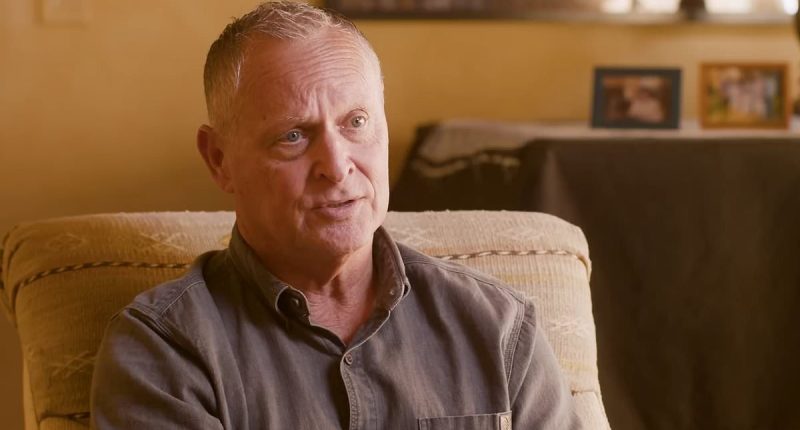Share this @internewscast.com
A man who died on the operating table for 45 minutes during his surgery has claimed he saw Jesus standing over him who showed him heaven.
Mike McKinsey, from California in the US, experienced the terrifying near-death experience while undergoing surgery to have his appendix removed.
In what doctors described as ‘the worst case they’d ever seen, the procedure took an unexpected turn, leaving him temporarily ‘dead’.
This means a person’s heart has stopped beating and they’ve stopped breathing, but they may still be able to be revived.
In Mr McKinsey’s case, doctors were forced to perform cardiopulmonary resuscitation, or CPR, to restart his heart and bring him back to life, he revealed in a recent viral video posted on the YouTube channel Coming Home.
Once ‘clinically dead’, he said he saw Jesus who he described as looking ‘like an Arab man’.
Wearing a white robe, the holy figure had ‘wavy brown hair’ and ‘dark greenish-blue eyes’, that he said ‘looked right into’ his soul.
When he reached out to take the hand Jesus offered him, he said he was transported to a meadow.

Mike McKinsey, from California in the US, had his own near-death experience during a surgery to have his appendix removed

When he looked at the source of the light, he said: ‘Jesus says to me “it’s the glory of the lord”,’ which left him weak in the knees
He recalled being barefoot in nothing but his surgical gown, standing on ‘perfectly manicured’ grass—with heightened senses allowing him to take in the moment.
Then, as he adjusted his eyes to the white, he said to his right was a bight light which ‘all of a sudden starts sending these beams.’
‘I felt the surgical room is now replaced with this beautiful warm feeling. All of a sudden somebody is pulling a curtain from my right to my left.
‘The white whatever it was—the white fog or veil or the just whiteness gets pulled to the side and now I’m looking at this beautiful scenery.’
He described standing on a hill above little flowers with soft petals that moved like they were dancing in the wind—which confused him as there was no wind.
‘There’s one big gold dome like a capital and there’s other smaller gold domes—I mean the city’s huge. It is miles apart,’ he said.
There was ‘the most beautiful’ sunset he had ever seen and then he noticed one of the tubes ‘of white’ hit the top of a tree.
‘It was like it had a diamond on it because when that thing hit the top of the tree it burst into hundreds of tiny little light streaks.

When he reached out to take the hand Jesus offered him, he said he was transported to a meadow
‘Pretty soon the whole mountain is lit with these bursting white beams of light and they kept’ which he described as being like ‘a big giant firework show.
When he looked at the source of the light, he said: ‘Jesus says to me “it’s the glory of the lord”.’
This was when he said he knew he couldn’t die, and was brought him back to the surgery room.
The first thing he remembers is the doctor asking him if he remembered his name or where he was.
This was when he realised there were five other people in the room dressed in scrubs and he heard someone say ‘he’s back’.
He realised he must have been resuscitated when he saw a crash cart next to him with one of the resuscitation paddles ‘kind of laying aside’ and ‘chords hanging down’.
‘It was obvious somebody had used it. Someone was over there putting them back together—and I thought, oh boy, I did die’ he said.
He spent 12 days in hospital losing two and a half stone, as he was initially on a liquid diet for six days, before being eventually allowed to eat banana.
Mr McKinsey first began to experience health problems in August 2024, when he started to suffer stomach issues while at a wedding, but it wasn’t until three days later he went to hospital.
It was at the hospital in Ventura, an hour-and-a-half drive to west of Los Angeles, he discovered his appendix had burst—which can be life-threatening.
He recalled the medical staff starting the IV, rolling him down the corridor, and saying goodbye to his wife.
While, he also doesn’t say whether his heart stopped and if so for how long, it is possible to be clinically dead for 45 minutes and survive with a defibrillator.
The phenomenon of near-death experiences has fascinated people and experts for millennia, but until recently there had been no scientific explanation.
In 2023, Dr Jane Aspell a professor of cognitive neuroscience at Anglia Ruskin University revealed recent research shed light on how the brain generates the experience of one’s self—and what happens when it goes wrong.
‘There is now strong evidence that out of body experiences, and related experiences, are caused by abnormal functioning in parts of the brain that process and combine signals from our bodies.
She explained it may be caused by damage to a vital part of the brain responsible for processing senses and balance.

Neuroscientist Dr Jane Aspell of Anglia Ruskin University, pictured, says out of body experience could be down to damage to a vital part of the brain responsible for processing senses and balance
This could explain why those who have come close to death, taken drugs or suffered from a brain injury are among those who have reported out of body experiences.
Such accounts have detailed cases of sufferers floating above their body that is lying down beneath them just after a traumatic event or accident.
The professor explained recent research shed light on how the brain generates the experience of one’s self—and what happens when it goes wrong.
The right side of the temporal parietal junction, which sits just above the ear is associated with out of body experiences, Dr Aspell explained.
This part of the brain is active during social functions, and needed to process empathy and memory.
It also draws on the senses of vision, sound and touch to create a coherent feeling of the self inside the body.
Part of the temporal parietal junction, called the vestibular cortex, acts as the balance system in our ears, helping us know where we are in relation to gravity.
The vestibular cortex could offer further explanation on out of body experiences, Dr Aspell believes.
If this area is not working properly, ‘the experience of being one single body might therefore be disrupted,’ explained Dr Aspell.
If the brain cannot combine information from this balance system with other senses, it can give the feeling of floating above your own body, explained Dr Aspell.














